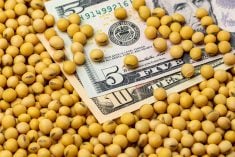This past year was another volatile 52-week period for the feeder cattle complex. Looking back at market reviews, I believe the lowest market sentiment was in late April when Charolais-cross steers were trading at $128 per hundredweight (cwt) in Lethbridge while barley was touching the $300 per tonne level.
This past week, similar cattle were about $20/cwt higher and barley is currently trading in the range of $160 to $163 per tonne south of Calgary.
Read Also

U.S. grains: Soy futures post biggest monthly gain in nearly five years on China trade optimism
U.S. soybean futures climbed to a 15-month high and posted their biggest monthly gain in nearly five years on Friday following a rally fueled by the prospect of revived exports to China.
Fed cattle were trading at $114/cwt on April 19 and reached up to $128/cwt just before Christmas. We clearly see how the feed grain and fed cattle markets have influenced the price of feeders. We’ve all seen how quickly the market environment can change within a short period of time, and 2014 will be no exception, given the upcoming risks.
Barley and feed wheat prices remain under pressure and have potential to drop lower as the commercial system contends with record supplies. Grain markets have switched from “seven years of want” to “seven years of plenty,” which is good news for cow-calf producers. There is a fair amount of grain looking for homes and the only places open for delivery are heifers and steers on feed for slaughter. Lower-quality milling wheat is moving into feed channels, because once warmer temperatures materialize, all these grain piles will have virtually little if any value.
The fed cattle market will be extremely dependant on consumer spending behaviour. Approximately 1.3 million Americans will lose their unemployment benefits this weekend. Despite the equity markets making fresh all-time highs, there appear to be two economies in North America and beef producers are selling product into both. The markets for ground beef and beef tenderloins will each have a fresh set of risk factors and the formula to determine the carcass value will continue to change.
— Jerry Klassen is a commodity market analyst in Winnipeg and maintains an interest in the family feedlot in southern Alberta. He writes an in-depth biweekly commentary, Canadian Feedlot and Cattle Market Analysis, for feedlot operators in Canada. He can be reached by email at [email protected] for questions or comments.












